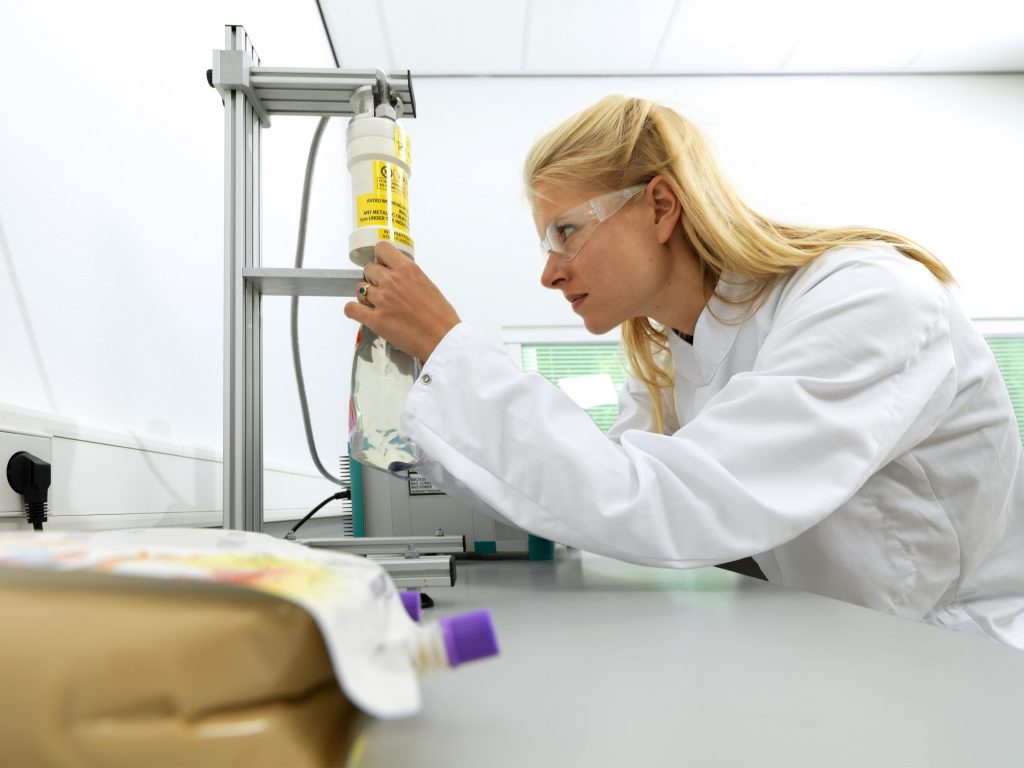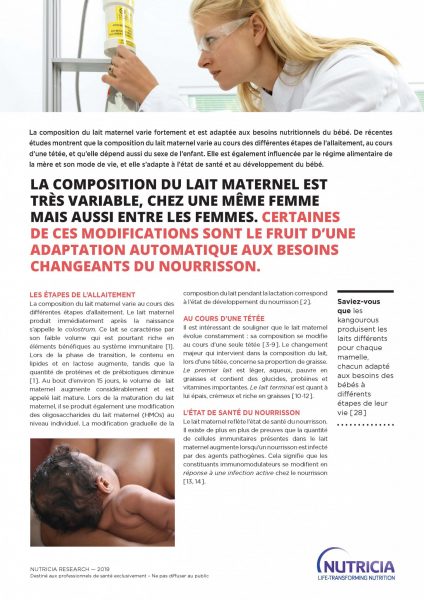De nombreux facteurs influencent la composition du lait maternel : l’alimentation, l’environnement, les gènes, les saisons et même le sexe du bébé.
Les étapes de l’allaitement
La composition du lait maternel varie durant les différentes étapes de l’allaitement. On appelle colostrum le lait produit immédiatement après la naissance. Son volume est faible, mais il est riche en éléments bénéfiques pour le système immunitaire1. L’étape suivante, dite de transition, voit la teneur en matières grasses et lactose augmenter, tandis que la quantité de protéines et de prébiotiques diminue1.
Au bout d’environ 15 jours, le volume de lait maternel augmente considérablement et ce dernier devient ce qu’on appelle le lait mature. Durant la maturation, on observe également une variation des oligosaccharides du lait maternel (HMO). La variation graduelle de la composition durant la lactation s’opère en adéquation avec le développement du nourrisson2.
Variations durant la tétée
Il est intéressant de noter que le lait maternel n’est pas constant : sa composition varie même au cours de la tétée3–9. La principale variation observée dans sa composition au cours d’une tétée est la teneur en matières grasses. Le lait de début de tétée est clair, liquide, pauvre en matières grasses et contient des glucides, protéines et vitamines importants. À l’inverse, le lait de fin de tétée est épais, crémeux et riche en matières grasses10–12.
État de santé du nourrisson
Le lait maternel reflète l’état de santé du nourrisson. De nouvelles données indiquent que le taux de cellules immunitaires dans le lait maternel augmente lorsque le nourrisson est infecté par des agents pathogènes. Les éléments immunomodulateurs varient donc en réponse à une infection active chez le nourrisson13,14.

Sexe de l’enfant
De récentes études ont découvert que les mères de garçons produisaient un lait maternel avec une teneur en calories 25 % plus élevée que les mères de filles, du moins dans les familles aisées. Ceci explique la croissance plus rapide des nouveau-nés masculins15–18.
Saison et climat
La composition du lait maternel peut varier selon l’environnement et les saisons. Sa teneur en eau s’adapte pour satisfaire les besoins liquides d’un bébé exclusivement allaité, même dans les environnements chauds et secs19. D’autre part, la quantité de composés anti-pathogènes présents dans le lait maternel des femmes de différentes régions est liée aux risques pathogènes associés à l’environnement spécifique du nourrisson20. Des éléments distincts du lait maternel, tels que la vitamine D ou les composants immunitaires, semblent également varier en fonction des facteurs saisonniers21,22.
Gènes maternels
La composition du lait maternel est régulée par des milliers de gènes, soit environ un quart à un tiers du génome. La variabilité, en termes de quantité et de qualité, des composants du lait maternel, tels que les lipides et les prébiotiques, s’explique en grande partie par les différences génétiques entre les mères dans le monde23–27.
Alimentation de la mère
Les études montrent que l’alimentation de la mère, y compris durant la grossesse, peut influencer la composition du lait maternel durant l’allaitement. La consommation maternelle de plusieurs vitamines, minéraux et d’une certaine quantité et qualité de matières grasses est liée à la composition du lait maternel28,29. Par exemple, certaines études révèlent un lien entre la consommation de poisson et la quantité de DHA* dans le lait maternel. D’autres études montrent une corrélation entre la consommation de vitamine C et la concentration en vitamine C du lait maternel. Une alimentation maternelle optimale est donc primordiale durant la grossesse et la lactation. Elle apporte non seulement au bébé la meilleure nutrition possible pour sa croissance et sa santé à court terme, mais elle contribue aussi à une meilleure santé de l’enfant tout au long de sa vie29,30.
Culture et mode de vie
La variabilité de la composition du lait maternel est en grande partie influencée, sans le savoir, par la façon dont la mère interagit avec son environnement et la culture de son entourage. Par exemple, la famille, les amis ou la culture locale déterminent souvent la façon dont une mère allaite31-33. L’expression de nombreux gènes impliqués dans la lactation est directement ou indirectement influencée par l’environnement extérieur et social. Par exemple, l’espacement et la durée des tétées sont aussi diversifiés que les modes de vie des gens. Ce comportement conditionné par la culture influence la constitution du lait maternel, notamment sa teneur en matières grasses, en énergie et en eau31–33.
*DHA : acide docosahexaénoïque

Publication : La composition du lait maternel est très variable chez une femme, mais aussi entre les femmes
Références
- Coppa, Giovanni V., et al. « Changes in carbohydrate composition in human milk over 4 months of lactation. » Pediatrics 91.3 (1993) : 637-641.
- Hanson, Lars Å., et al. « The transfer of immunity from mother to child. » Annals of the New York Academy of Sciences 987.1 (2003) : 199-206.
- Mizuno, Katsumi, et al. « Is increased fat content of hindmilk due to the size or the number of milk fat globules? » International breastfeeding journal 4.1 (2009) : 7.
- Hartmann. (2007) Dans : Hale & Hartmann’s Textbook of Human Lactation : 3-16.
- Coppa, G. V., et al. « Prebiotics in human milk: a review. » Digestive and Liver Disease 38 (2006) : S291-S294.
- Newburg, David S. « Are all human milks created equal? Variation in human milk oligosaccharides. » Journal of pediatric gastroenterology and nutrition 30.2 (2000) : 131-133.
- Gluckman, Peter D., et al. « Effect of in utero and early-life conditions on adult health and disease. » New England Journal of Medicine 359.1 (2008) : 61-73.
- Field, Catherine J. « The immunological components of human milk and their effect on immune development in infants. » The Journal of nutrition 135.1 (2005) : 1-4.
- Blewett, Heather J. Hosea, et al. « The immunological components of human milk. » Advances in food and nutrition research 54 (2008) : 45-80.
- Lönnerdal, B. O. « Effects of maternal dietary intake on human milk composition. » The Journal of nutrition 116.4 (1986) : 499-513.
- Neville, Margaret C., et al. « Studies on human lactation. I. Within-feed and between-breast variation in selected components of human milk. » The American journal of clinical nutrition 40.3 (1984) : 635-646.
- Allen, Jonathan C., et al. « Studies in human lactation: milk composition and daily secretion rates of macronutrients in the first year of lactation. » The American journal of clinical nutrition 54.1 (1991) : 69-80.
- Hassiotou, Foteini, et al. « Maternal and infant infections stimulate a rapid leukocyte response in breastmilk. » Clinical & translational immunology 2.4 (2013) : e3.
- Riskin, Arieh, et al. « Changes in immunomodulatory constituents of human milk in response to active infection in the nursing infant. » Pediatric research 71.2 (2012) : 220.
- Fujita, Masako, et al. « In poor families, mothers’ milk is richer for daughters than sons: A test of Trivers–Willard hypothesis in agropastoral settlements in Northern Kenya. » American journal of physical anthropology 149.1 (2012) : 52-59.
- Hinde, Katie, et al. « Holsteins favor heifers, not bulls: biased milk production programmed during pregnancy as a function of fetal sex. » PloS one 9.2 (2014) : e86169.
- Michaelsen, Kim Fleischer, et al. « The Copenhagen Cohort Study on Infant Nutrition and Growth: breast-milk intake, human milk macronutrient content, and influencing factors.» The American journal of clinical nutrition 59.3 (1994) : 600-611.
- Powe, Camille E., Cheryl D. Knott et Nancy Conklin‐Brittain. « Infant sex predicts breast milk energy content. » American Journal of Human Biology: The Official Journal of the Human Biology Association 22.1 (2010) : 50-54.
- Sachdev, H. P. S., et al. « Water supplementation in exclusively breastfed infants during summer in the tropics. » The Lancet 337.8747 (1991) : 929-933.
- Morrow, Ardythe L., et al. « Human milk oligosaccharides are associated with protection against diarrhea in breast-fed infants. » The Journal of pediatrics 145.3 (2004) : 297-303.
- Ala-Houhala, M., et al. « 25-Hydroxyvitamin D and vitamin D in human milk: effects of supplementation and season.» The American journal of clinical nutrition 48.4 (1988) : 1057-1060.
- Salameh, Khalil, et al. « Prevalence and risk factors for low vitamin D status among breastfeeding mother–infant dyads in an environment with abundant sunshine. » International journal of women’s health 8 (2016) : 529.
- Lemay, Danielle G., et al. « The bovine lactation genome: insights into the evolution of mammalian milk. » Genome biology 10.4 (2009) : R43.
- Maningat, Patricia D., et al. « Gene expression in the human mammary epithelium during lactation: the milk fat globule transcriptome. » Physiological genomics 37.1 (2009) : 12-22.
- Ameur, Adam, et al. « Genetic adaptation of fatty-acid metabolism: a human-specific haplotype increasing the biosynthesis of long-chain omega-3 and omega-6 fatty acids. » The American Journal of Human Genetics 90.5 (2012) : 809-820.
- Coppa, Giovanni V., et al. « Oligosaccharides in 4 different milk groups, Bifidobacteria, and Ruminococcus obeum. » Journal of pediatric gastroenterology and nutrition 53.1 (2011) : 80-87.
- Thurl, Stephan, et al. « Variation of human milk oligosaccharides in relation to milk groups and lactational periods.» British Journal of Nutrition 104.9 (2010) : 1261-1271.
- Lönnerdal, B. O. « Effects of maternal dietary intake on human milk composition. » The Journal of nutrition 116.4 (1986) : 499-513.
- Wong, William W., et al. « Effect of dietary cholesterol on cholesterol synthesis in breast-fed and formula-fed infants. » Journal of lipid research 34.8 (1993) : 1403-1411.
- Mennella, Julie A. et Gary K. Beauchamp. « Maternal diet alters the sensory qualities of human milk and the nursling’s behavior. » Pediatrics 88.4 (1991) : 737-744.
- Anderson, Steven M., et al. « Key stages in mammary gland development. Secretory activation in the mammary gland: it’s not just about milk protein synthesis! » Breast Cancer Research 9.1 (2007) : 204.
- Lemay, Danielle G., et al. « Gene regulatory networks in lactation: identification of global principles using bioinformatics. » BMC systems biology 1.1 (2007) : 56.
- Solter, Aletha Jauch. The aware baby. Shining Star Press, 2001.
BA19-485
